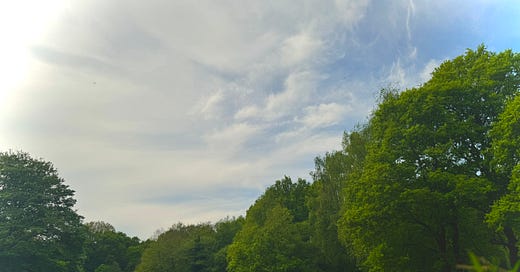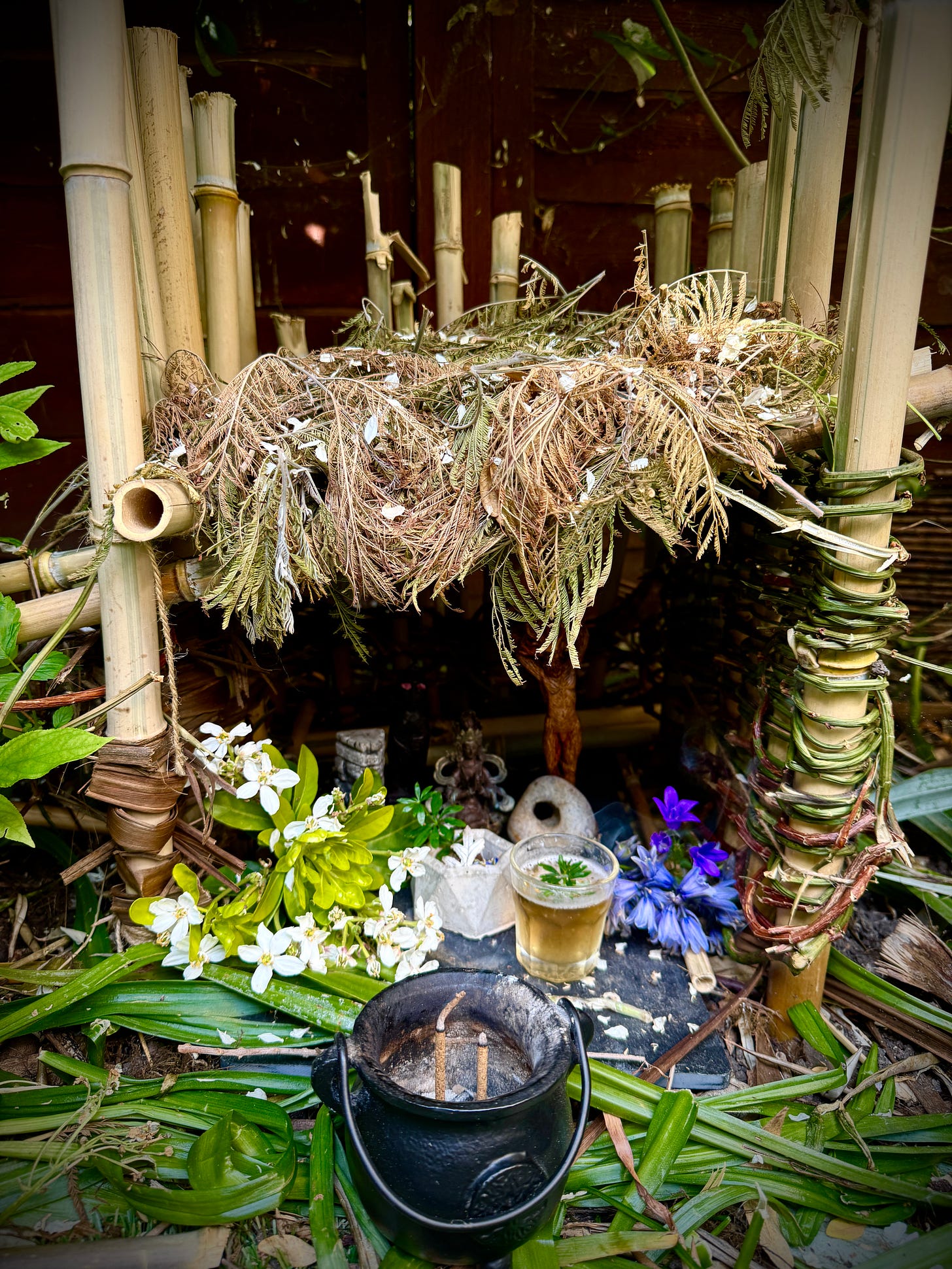May 1st, May Day, is known as Beltane/Beltaine/Bealtuinn in Celtic traditions (or Calan Mai in Welsh), marking the height of Spring and its gradual progression into Summer — the converse of Samhain/Samhuinn (October 31st/November 1st), which marks the beginning of the descent into Winter.
Traditionally, the chief focus of Beltane was fertility, both of the land and its inhabitants. This was the time when cattle would be brought out to pasture, so their ritual safeguarding was secured through rituals of purification, protection, and the securing of abundance. Hawthorn (or ‘Mayflower’) boughs would be gathered and placed in entryways for protection, and sacred wells and springs would be visited — with some believing that the first draw from such a spring on Beltane morning would confer magical health and beauty.
Most importantly, this was also an opportunity to make offerings to the spirits/fays of the land, like the Aos sí, Tylwyth Teg, or ‘Fairies’. While Samhain is primarily associated with the dead, Beltane belongs to the lively, liminal non-human ‘others’: the spirited beings who dwell in (and are embodied in) the so-called ‘natural’ world.
In modern times, many still associate Mayday with the custom of dancing around a Maypole — a distinctly Germanic tradition — while Celtic societies practiced similar rites with trees. But at its core, Beltane is very much a fire festival, with the name likely derived from Proto-Celtic *belo-te(p)niâ, ‘bright fire’. It was common for both humans and non-human animals to walk between or circumambulate (or even jump over) ceremonial fires for protection from disease, the removal of curses, and to encourage fertility in the year ahead. In this context, the fire acts as a kind of sympathetic expression of the Sun, whose power grows daily in our journey towards the Summer Solstice.
In astrological terms, this is, of course, the height of Taurus season — the feminine expression of ‘fixed’ earth energy, ruled by the planet Venus. ‘Fixed’ signs anchor the middle of each season, exemplifying stability, persistence, and full embodiment. While ‘Cardinal’ signs lead the charge into a new season and ‘Mutable’ signs begin to flexibly give way to what’s to come, Fixed signs are quintessential expressions of the season at hand. In Taurus, this energy is grounded in sensuality, creativity, and the living Earth. Beltane represents the height of this energy, occurring (roughly) midway between the Spring Equinox and Summer Solstice.
The Birth of Flowers
In Tolkien’s mythology, May Day loosely coincides with the Elvish festival of Nost-na-Lothion, or the ‘Birth of Flowers’, which was observed (at least) by the elves of Gondolin, marking the occasion when the snow and ice of the Encircling Hills would melt and flow into Tumladin, causing the vale to “burst into flowers” —certainly including Lesser Celandine, for which the ‘House of the Golden Flower’ is named. This festival was likely held sacred to the goddess Vána, for whom “all flowers spring as she passes”.
Following the Elvish New Year, this was the first of the Spring festivals celebrated amongst the Eldar, with the second (Tarnin Austa, the ‘Gates of Summer’) marking its end. It’s unclear when, precisely, this festival would have occurred, but Tolkien almost certainly had May Day/Beltane in mind when he documented it. He writes:
“in its time a spring of wondrous glory melted the skirts of those white mantles and the valley drank the waters and burst into flowers. So came and passed with revelry of children the festival of Most-na-Lothion or the Birth of Flowers, and the hearts of the Gondothlim were uplifted for the good promise of the year”
(BOLT II, 171-72)
At the end of the Third Age, May 1st also marked the coronation of King Elessar (Aragorn) in Gondor, thus establishing the Reunited Kingdom of Gondor and Arnor — the blossoming of a new age. Tolkien writes,
“Tall as the sea-kings of old, he stood above all that were near; ancient of days he seemed and yet in the flower of manhood; and wisdom sat upon his brow, and strength and healing were in his hands, and a light was about him"
(LOTR, 1004)
It was also at this time that Aragorn took the ‘Oath of Elendil’, originally spoken by his ancestor as he first stepped foot on the shores of Middle-earth after the Fall of Númenor. This Quenya formula has always been one of my favourite pieces of Elvish writing, almost approaching a kind of ‘Bodhisattva’ vow. It was also beautifully sung by Viggo Mortensen in the Peter Jackson adaptation of The Return of the King, who personally created the melody used in the film:
Et Eärella Endorenna utúlien. Sinome maruvan ar Hildinyar tenn’ Ambar-metta!
‘Out of the Great Sea to Middle-earth I am come. In this place will I abide, and my heirs, unto the ending of the world’
(LOTR, 1003-04)
Connecting with the Season
There are many ways that one could connect with the spirit of this season. You could light a fire or candle (or two), make some art, or simply go for a stroll and gather some wildflowers. In addition to holding a small personal ceremony, I spent the majority of the day outside, enjoying some of the unseasonably warm weather we've been having in London, and taking in the many sights and smells of Spring.
For herbalists, this is, of course, a perfect time to collect Hawthorn blossoms (Crataegus spp.), one of the superlative plant medicines for the heart — both physical and figurative. While the berries are most commonly used in modern herbal medicine, the blossoms offer somewhat gentler potency, and are often specifically used for emotional support. It’s notable that Hawthorn blossoms contain the chemical compound trimethylamine, which gives them their rather distinctive (and mildly unpleasant) smell. This is actually one of the compounds released when animal tissue decomposes, making this one of the ‘smells of death’. It is perhaps for this reason that it has long been deemed inauspicious to bring Hawthorn blossoms into one’s home, but it is also rather fitting that Hawthorn-based remedies would have a kind of sympathetic therapeutic effect on those struggling with grief and loss.
Hawthorn has long held deep spiritual and magical associations in the British Isles, originally viewed as connected to the Fair Folk. Farmers would go to great lengths not to disturb a thorn tree growing in their field, lest they provoke the ire of the land’s spirits, while in Ireland it was sometimes said that a Hawthorn in one’s hedge (‘Hawthorn’ is actually another way of saying ‘Hedge-thorn’) would help to ward off malevolent fairies. After Christianisation, the significance of the Hawthorn was retained and repackaged in Britain, becoming identified with the crown of thorns placed on Jesus’s head at his crucifixion. Others hold that Jesus’s birth occurred under a Hawthorn tree. One particular tree — the so-called ‘Holy Thorn’ of Glastonbury — was even believed to have sprung from the walking stick of Joseph of Arimathea, who is said (in British tradition) to have journeyed there after the crucifixion. A descendant of this tree (a Crataegus monogyna 'Biflora') still stands in the grounds of Glastonbury Abbey, and is revered for the fact that it is often in bloom at Christmas. Traditionally, a bough from the Holy Thorn is taken to adorn the dining table of the British sovereign at Christmas.
Offering to the Unseen Beings
Most importantly (at least to me), the Beltane season is a powerful time to connect with the spirits of one’s land — the non-human ‘others’ with whom we share this Earth. There are many ways that one could do this: for instance by offering flowers, food, libations, incense, or tokens of care and appreciation at a special spot. I recently made a simple ‘spirit house’ in my back garden for just such a purpose. One needn’t be wholly committed to the literal existence of fairies and elves to engage in such a practice, nor are there any immutable standards for what such a structure should look like. What’s important is the development of a personal and affective relationship with the land, treating it as an ‘inspirited’ subject rather than a mere domain of objects. When we work to cultivate such a relationship, we open ourselves up to the possibility of genuine care.
Offerings can take many forms. In many cultures, milk was a favoured offering to be made to ‘unseen beings’ like elves, fairies, and even the nāgas of India. Part of the reason for this may be the belief that such beings are wont to steal the milk from one’s cattle — thus by offering them their own sacrificial portion, one could reserve the milk for human consumption. Naturally, as a vegan, I do not use dairy products in my offerings, but this is no matter. It is generally advisable to offer the kinds of things that we value as individuals, since an offering is meant to represent a kind of personal ‘sacrifice’ — something that we value and enjoy, offered freely so that others may also enjoy it. In my Beltane offering, I included some homemade incense, flowers from my garden, and a bit of English beer infused with Sweet Woodruff (Galium odoratum), a popular ingredient in Maiwein (‘May Wine’), which is traditionally imbibed on May Day in parts of Germany and Belgium.
Besides making offerings, we can also attend to the spirits of the land by simply sitting and being present with the many ‘unseen beings’ in our midst. Beltane is an opportunity to intentionally re-enchant ourselves with the world around us — whatever form that may take. You may want to make some art, sing a song, or write a poem or story. Creative engagement is a powerful method for shifting our relationship with the Earth.
A Time to Tend
As the days lengthen and warm, Beltane asks us to pause and notice the world in bloom. Not just the visible signs of spring, but the quiet and subtle presence of the many unseen beings who animate the land. It’s a reminder that the world is not made up solely of objects to be named or used, but of relationships to be honoured, tended, and renewed.
This season offers us a precious chance to re-enchant our experience as living beings in a living world — to remember that the Earth is alive with presences and patterns that don’t begin or end with us. We don’t necessarily need to mythologise the season to meet it honestly. We only have to look, to listen, and to respond with care. Small gestures. Moments of contact. An openness to something other (not ‘greater’ or ‘lesser’) than ourselves.
Because in the end, that’s the point. To remember we’re not alone here. To walk through the world in relationship with the many enchanting others in our midst — not as their owners, but as their kin.







Very interesting - and I especially loved reading your final 2 paragraphs - beautiful words and a belief that accords with mine. Thank you!
Beautiful. Thank you for honoring this sacred turn of the wheel. According to a seanchi (storyteller) I was listening to yesterday, in rural Ireland farmers would walk their land with Gorse or yellow primrose petals on Bealtaine and place them at the 4 corners/boundaries as protection/blessing. They would also look for signs of that a neighbor had buried a dead lamb or calf or rotted eggs on their property to sabotage their luck. I would love the see the big Bealtaine fire ritual on the Hill of Uisneach one day...